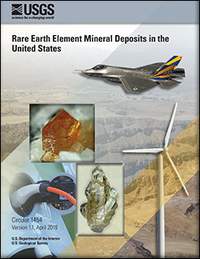Rare Earth Element Mineral Deposits in the United States
Links
- Document: Report (23.2 MB pdf)
- Version History: Version History (4.0 kB txt)
- Download citation as: RIS | Dublin Core
Abstract
Because of their unique special chemical properties, many of the metals in the group of rare earth elements (REEs) have essential applications in 21st century technologies. Examples of products that use REEs are cell phones, computers, fluorescent and light-emitting-diode lights, flat-screen television and computer monitors, and in high-strength magnets used by clean energy technologies such as the generators of wind turbines and batteries of hybrid and electric vehicles. REEs are used in many defense applications, such as in components of jet engines, missile guidance systems, antimissile defense systems, satellites, and communication systems.
The rare earth elements have become vital to manufacturing numerous high-tech products, which has been accompanied by a large increase in their demand. At the same time, there has been concern by the United States and many other Nations about the near-monopoly of mining, processing, and supply of REEs from one Nation, China. Between 2011 and 2017, China produced approximately 84 percent of the world’s REEs, and during this time the United States only produced REEs between 2012 and 2015. The U.S. production came entirely from the Mountain Pass mine in California, providing only about 4 percent of the world REE supply. Because REEs are essential for technological applications and are primarily supplied by one Nation, there has been an increased concern in identifying new sources of REEs, including economic REE deposits.
In response to these concerns, since 2009, the U.S. Geological Survey (USGS) has conducted numerous studies focused on the distribution, geology, and potential resources for the REE-bearing mineral deposits in the United States. The basic characteristics of mineral deposit types that host REE enrichments in the United Sates are summarized in this report, with selected examples. Several types of REE-enriched mineral deposits are reviewed, including deposits in carbonatites, alkaline igneous rocks, sedimentary phosphate-rich rocks (phosphorite), regions containing REE-rich veins, iron oxide deposits containing REE-bearing apatite, monazite-xenotime-bearing placer deposits (heavy-mineral sands), and ion-adsorption clay deposits (REE in granite-derived regolith). A better understanding of these mineral deposits will assist in identifying domestic resources to help alleviate the dependence on imported REEs.
The economic development of REE mineral deposits is affected by many factors beyond mining, such as commodity prices and mineral processing costs. Most of the REEs are hosted by minerals that have complex chemical formulas; this presents more challenges to process and extract the REEs. Continued advancements and refinements in mineral processing techniques may allow REE deposits with complex mineralogy to be economically developed in the future.
Suggested Citation
Van Gosen, B.S., Verplanck, P.L., and Emsbo, Poul, 2019, Rare earth element mineral deposits in the United States (ver 1.1, April 15, 2019): U.S. Geological Survey Circular 1454, 16 p., https://doi.org/10.3133/cir1454.
ISSN: 2330-5703 (online)
ISSN: 1067-084X (print)
Table of Contents
- Abstract
- Introduction
- Rare Earth Elements
- Supply Concerns
- Principal Rare Earth Element Minerals in Economic Nonfuel Mineral Deposits
- Rare Earth Element Mineral Deposit Types in the United States
- Summary
- References
| Publication type | Report |
|---|---|
| Publication Subtype | USGS Numbered Series |
| Title | Rare earth element mineral deposits in the United States |
| Series title | Circular |
| Series number | 1454 |
| DOI | 10.3133/cir1454 |
| Edition | Version 1.0: April 11, 2019; Version 1.1: April 15, 2019 |
| Publication Date | April 11, 2019 |
| Year Published | 2019 |
| Language | English |
| Publisher | U.S. Geological Survey |
| Publisher location | Reston, VA |
| Contributing office(s) | Central Mineral and Environmental Resources Science Center, Mineral Resources Program |
| Description | iv, 16 p. |
| Country | United States |
| Online Only (Y/N) | N |


